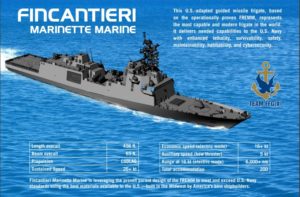Top Navy officials on Thursday laid out the expected costs and timetable of the newly awarded Fincantieri FFG(X) frigate contract win and estimated follow-on vessels will stay below the target price of $800 million each.
On April 30, the Navy awarded Fincantieri a $795 million contract for the detail design and construction (DD&C) of the FFG(X) over three rival bids. It includes options to deliver up to a total planned 10 ships at a total cost of $5.576 billion. The Navy plans to eventually purchase a total of 20 frigates (Defense Daily, April 30).

“We will start detail design in May, tomorrow. We will start construction no later than the April of 2022. We expect delivery of the first ship in 2026 with [Initial Operating Capability] in the ‘29-‘30 timeframe and [Full Operating Capability] in the ‘31-‘32 timeframe,” Assistant Secretary of the Navy for Research, Development and Acquisition James Geurts told reporters during a press call Thursday.
“The cost for the lead ship is $1.281 billion dollars. That includes $795 million for the shipbuilder as well as an additional cost for government furnished equipment, test integration, program office, and all of the other things,” he continued.
Geurts noted the $795 million includes design money and not just construction of the first ship.
He explained the Navy’s current independent cost estimate shows the Fincantieri selection will have an average cost of $781 million in constant year 2018 dollars. In comparison, the Navy’s requirements for follow-on ship cost have an objective of $800 million with a maximum threshold of $950 million, in constant year 2018 dollars.
In 2019, a Navy official said the service expects the follow-on vessels to cost close to $800 million each on average while the service previously said they will have a maximum cost of $950 million (Defense Daily, Jan. 17, 2019).
“So our current independent cost estimate shows this ship as selected and the program as designed delivering underneath our objective cost per platform,” Geurts argued.
Geurts said the cost estimate is based on a single provider over the projected full 20-vessel plan and expects the cost to go down not only because follow-on ships will not have the design dollars attached, but the shipbuilder will have “an aggressive cost curve” and “you’ll see them achieve learning as they work their way through the program.”
The Navy’s FY 2021 budget request documents plan pushed back the FFG(X) schedule to avoid moving too fast and replicating issues that occurred in the Littoral Combat Ships (LCSs) (Defense Daily, Feb. 11).
That FY ’21 plan expects the Navy to buy one frigate each in FY ’21 and FY ’22 then two each in FY ’23 and FY ’24, before moving to three in FY ’25, totaling nine over five years.
The Frigate has “about a four-year construction span anticipated, plus typically obviously after we deliver ships we put them through a series of testing & crew adaptation so we’re talking about early to mid ‘30s by the time we’re done with all of the effort for all of the first 10 ships,” Rear Adm. Casey Moton, Program Executive Officer for Unmanned and Small Combatants, said during the call.
Geurts noted that is also dependent on the procurement profile.
“That’s kind of assuming our current profile of procuring the first 10 by 2025. Obviously, that can be adjusted depending on that buy profile.”
Geurts reiterated they estimate the DD&C contract was awarded almost six years earlier compared to traditional shipbuilding acquisition schedules because they first worked with shipbuilders to shape requirements for the platform.
“All this was done with an intense focus on cost, acquisition and technical rigor so that we got the best value for our warfighter and taxpayer. It’s the best I’ve seen in the Navy thus far at integrating all of our teams together and it’s a model that we are building on for future programs,” he said.
Geurts said the award was not pushed out faster due to the COVID-19 pandemic, like other recent contracts (Defense Daily, April 16).
He underscored he and others in the Navy has previously talked about trying to award the contract as early as possible in FY 2020 “while ensuring we protected the integrity and the discipline of the process.”
The Navy originally planned to award FFG(X) in the July to September timeframe, but he applauded all the participants for working extra fast, including competitors.
“Everyone has worked, understanding the importance and criticality of this program to the fleet. Everybody has worked really well together in an aggressive but very disciplined schedule…it is somewhat unprecedented for us to be able to execute this on the schedule we had, a source selection of this complexity in the midst of the COVID [pandemic] and the team continuing to work, not letting the COVID delay of our efforts over the last six to eight weeks,” Geurts said.
While this early award was not driven by the pandemic response, “three months early, obviously, helps us from an industrial base standpoint and provides more stability in the shipyards as we move forward.”